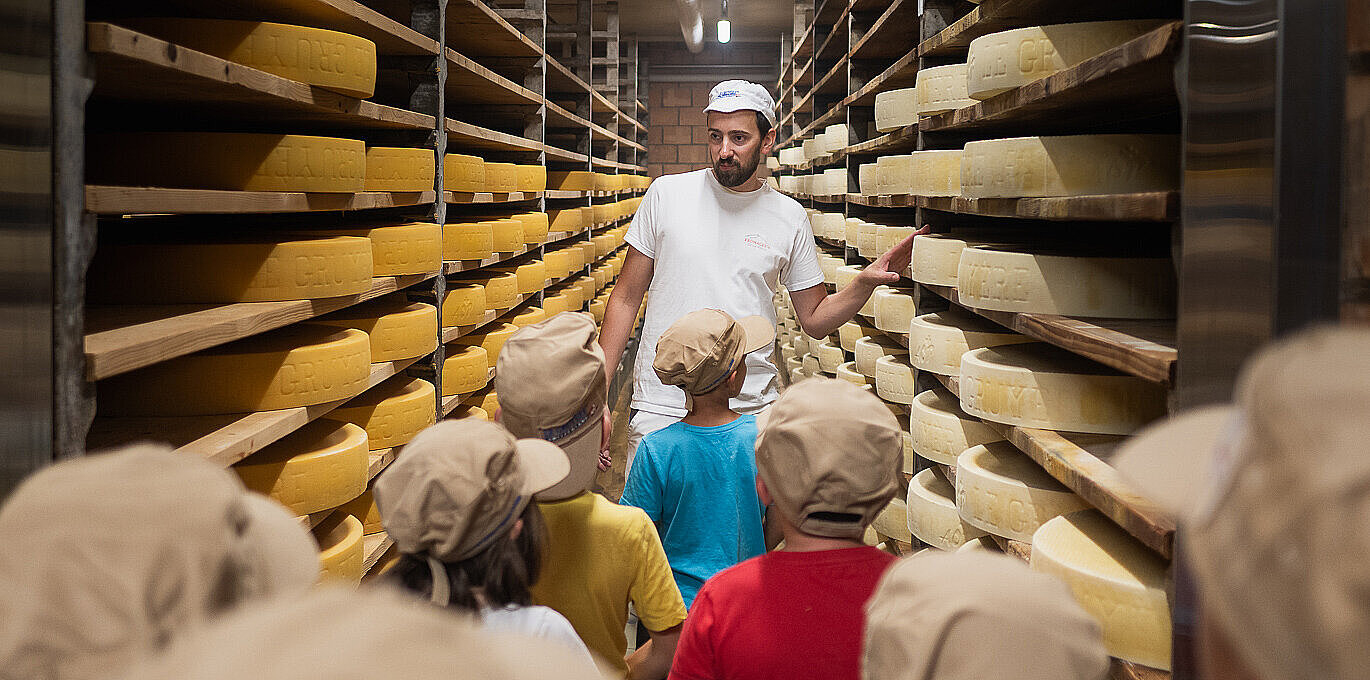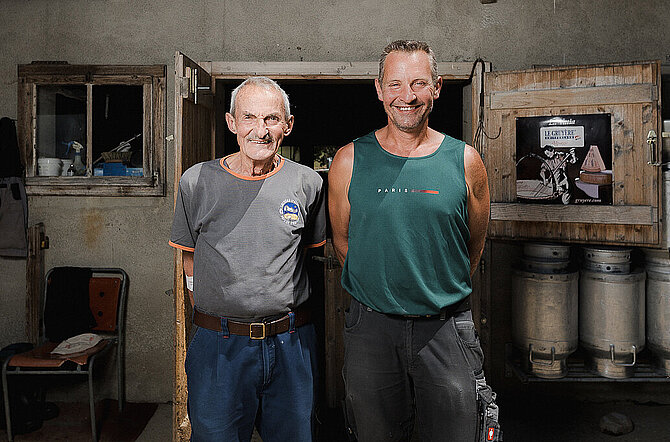Cheese-making know-how explained to children
In La Roche (Fribourg), Gabriel Moura, a committed young master cheese-maker is opening the doors of his cheese dairy to children throughout the summer. The visit includes a tour of the production facilities and the cellar, as well as a tasting of Le Gruyère AOP cheese. “You have to encourage an appetite for it”, he says.

"Presenting the profession is also part of our mission !"
Gabriel Moura, master cheesemaker at La Roche (FR)
Butter, milk, yoghurts and cheeses are served every day to children at the Estavayer-le-Lac holiday camp, staying for a dozen days at the Biéla chalet, on the heights of La Roche. This morning, led by their educators, around sixty children aged between 6 and 12 are getting ready to discover the cheese-making process at Gabriel Moura's La Roche cheese dairy. It's a tried and tested exercise for the cheese-maker and his partner Élodie, who welcome children in the summer (up to 5 groups this July): “Some children don't even know where milk comes from or what it's used for. The visits are a way of providing information and arousing interest, both in the products and in the profession”, explains the cheese-maker, aware of the lack of vocations in the dairy professions. Sometimes a visit leads to a request for a work placement, which Gabriel Moura always accepts: “I would never have taken up this profession if it hadn't been for the work placements that introduced me to it,” he recalls.
Seeing and tasting
“Are you the boss?”. With his new Le Gruyère AOP cap screwed on his head and overshoes on his feet, a boy calls out to Gabriel Moura. In front of the premises, the “boss” introduces its first special feature: when the milk is received, a pump sucks the precious liquid out of the churns and pours it into the vats inside. A few figures impress the young audience: every day, without exception, 34 producers bring in milk from some 1000 cows grazing in and around the village. Before the process of making Le Gruyère AOP begins, the milk is weighed, filtered and analysed to guarantee its quality. Without dwelling on the technical details, Gabriel Moura stresses the importance of sample checks for the rest of the process. He explains: “The children start the tour following the path taken by the milk, from reception to storage, but I spare them the finer details, as they're more interested in seeing and tasting!”.
Welcome bacteria
One of Gabriel Moura’s employees is busy working around a vat as the milk begins to curdle, revealing the whey that will be used to make butter - along with the cream - and to feed the 800 or so pigs in the village! The cheese-maker emphasises the economic and ecological benefits of this use. At the end of the production process, the cheese wheels are marked with the Le Gruyère AOP designation and a casein mark is affixed. All the children are familiar with the famous cheese, and Sven, aged 7, makes no secret of his enthusiasm: “I love Gruyère!” he exclaims, adding that he eats it every day. The looks on the children’s faces become a little dubious when Gabriel Moura mentions the bacteria cultures needed to acidify the milk and process it. But they remain focused, nonetheless. For most of them, this visit is a first.
Learning to identify the qualities of Le Gruyère AOP
Then it's time to discover the special world and cool, damp atmosphere of the cellar. The smells of ammonia and brine are not to everyone's taste, but the quantity and size of the cheese wheels are impressive. The group makes its way between the cellar shelves, surrounded by young, very light-coloured cheeses and older ones with darker, more solid rinds. There is also mention of the refiner and his indispensable probe, which sometimes reveals holes that will deprive the cheese of its AOP designation. “So do you just throw it away?”, wonders one participant. The La Roche cheese-maker reassures her that as long as it doesn't affect the flavour, cheese with holes is sold grated or packaged for fondue. When asked by their host, the children chorus the criteria for a good Le Gruyère AOP cheese: no holes, elasticity, flavour, appearance and conservation.
Once back in the open air, they are invited to taste Le Gruyère AOP cheeses of varying degrees of ripeness. One of them backs away; he doesn’t like cheese. To peals of laughter from the children around him, one of them says: “When I become a farmer, I’ll have 150 cows”. For Gabriel Moura, despite the organisational challenges, the experience is always conclusive: “Our whole team enjoys communicating, and in some regions, there are fewer cheese dairies than in our canton. Presenting the profession is also part of our mission”, he says.
Figures:
- 320 tonnes of Le Gruyère AOP produced annually
- Up to 3300 wheels in the cellar/li>
- 12 employees, including 2 apprentices
- 34 milk producers






